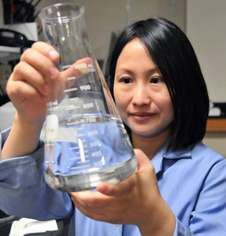What's in our water?

(PhysOrg.com) -- Although America's supply of drinking water is considered among the world's safest, there is an urgent need to develop more stringent regulations to guide how water is monitored for pollutants, according to April Gu, assistant professor of civil and environmental engineering at Northeastern University. Gu is working on the fundamental research underlying our ability to identify and monitor real and potential pollutants in water and remove them at lower cost than is now possible.
Funded by the National Science Foundation and the Water Environment Research Foundation, Gu and her colleagues hope to provide the necessary information to improve--both in cost and efficiency--how water treatment facilities remove pollutants from wastewater before it is released into the environment—our bays, harbors, rivers, and lakes.
Boston’s largest wastewater treatment facility, housed on Deer Island, treats 370 million gallons of sewage each day from 43 communities in Massachusetts. Gu is looking at how a treatment facility like this can improve current contaminant removal processes to make the water safer.
She is exploring a method to monitor how genes in bacteria are expressed when exposed to emerging contaminants, including nanomaterials and other toxic compounds that are products of new technology-driven industries. The data collected on the genetic reactions will provide fundamental toxicity data about the chemicals present in the water. This, said Gu, would provide a scientific basis on which to develop updated and accurate federal water regulations.
“Industrialization has led to a dramatic increase in the number of potential toxins in our water supply, yet we do not have sufficient monitoring systems in place that can detect them,” said Gu. “This sophisticated and reliable technique will help researchers evaluate and identify a greater number of potential contaminants, vastly improving our water assessment processes.”
Gu and her colleagues are also examining the impact of wastewater-derived organic nutrients on eutrophication, a process that leads to the overgrowth of nutrients in lakes, streams, rivers and other bodies of fresh water. The abundance of these nutrients, such as nitrogen and phosphorous, causes excessive growth of algae and other aquatic plants, which in turn causes fish and shellfish and other plant species to die from a lack of oxygen.
Eutrophication decreases the resource value of rivers, lakes and estuaries, and is still the leading cause of deterioration in our nation’s water supply, said Gu, whose research also focuses on improving ways to remove this form of pollution.
“We need to better monitor the water for pollutants, and most importantly, develop innovative and cost-effective ways to remove these pollutants to make drinking water as safe as possible,” she said.
Provided by Northeastern University (news : web)

















